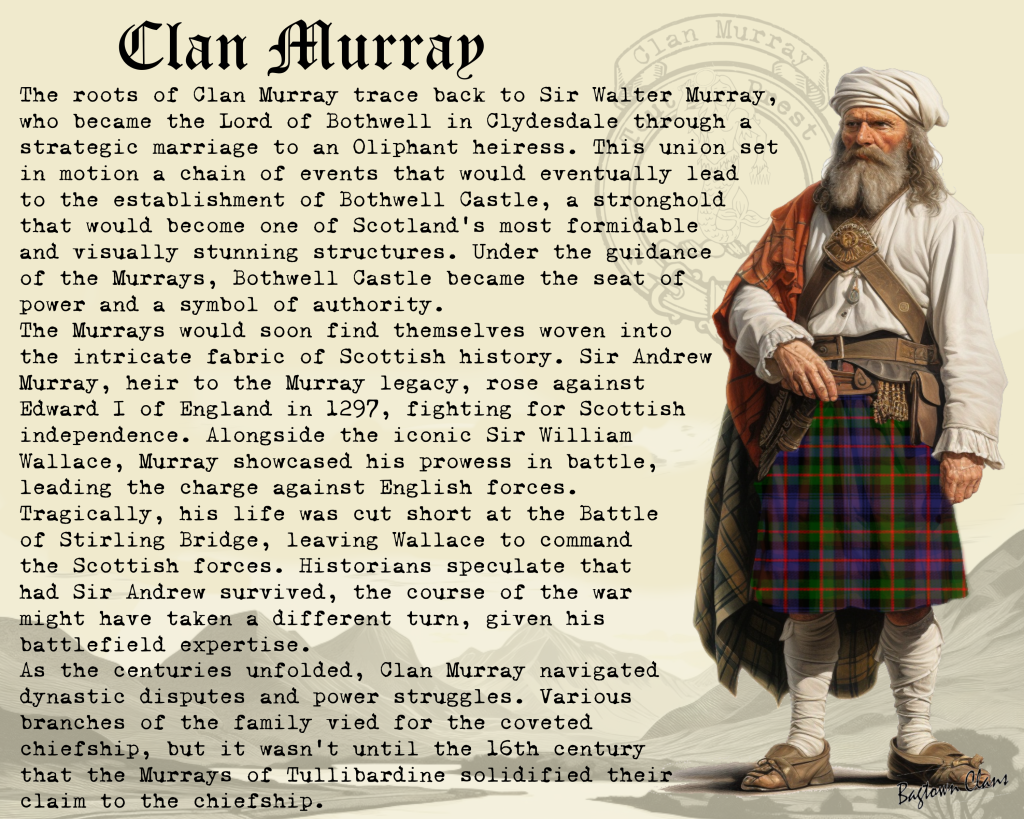 The roots of Clan Murray trace back to Sir Walter Murray, who became the Lord of Bothwell in Clydesdale through a strategic marriage to an Oliphant heiress. This union set in motion a chain of events that would eventually lead to the establishment of Bothwell Castle, a stronghold that would become one of Scotland’s most formidable and visually stunning structures. Under the guidance of the Murrays, Bothwell Castle became the seat of power and a symbol of authority. The roots of Clan Murray trace back to Sir Walter Murray, who became the Lord of Bothwell in Clydesdale through a strategic marriage to an Oliphant heiress. This union set in motion a chain of events that would eventually lead to the establishment of Bothwell Castle, a stronghold that would become one of Scotland’s most formidable and visually stunning structures. Under the guidance of the Murrays, Bothwell Castle became the seat of power and a symbol of authority.
The Murrays would soon find themselves woven into the intricate fabric of Scottish history. Sir Andrew Murray, heir to the Murray legacy, rose against Edward I of England in 1297, fighting for Scottish independence. Alongside the iconic Sir William Wallace, Murray showcased his prowess in battle, leading the charge against English forces. Tragically, his life was cut short at the Battle of Stirling Bridge, leaving Wallace to command the Scottish forces. Historians speculate that had Sir Andrew survived, the course of the war might have taken a different turn, given his battlefield expertise.
As the centuries unfolded, Clan Murray navigated dynastic disputes and power struggles. Various branches of the family vied for the coveted chiefship, but it wasn’t until the 16th century that the Murrays of Tullibardine solidified their claim to the chiefship. This was formalized through “bands of association” that recognized the leadership of Sir John Murray, later known as the first Earl of Tullibardine. Despite these disputes, Abercairny, a branch of the Murrays, continued to prosper and contribute to the clan’s illustrious history.
The Murrays’ ascendancy was further solidified through strategic alliances. John Murray of Tullibardine was granted the title of Earl in 1606, followed by his son’s marriage to Dorothea Stewart, heiress to the Earls of Atholl. This union brought vast lands under their control, leading to the transformation of the Stewart earldom of Atholl into a Murray earldom and eventually a marquessate. In 1703, the pinnacle of nobility was reached when the Murrays were granted the title of Dukes of Atholl.
The Murrays’ influence wasn’t limited to political and military spheres. Lord George Murray, a remarkable Jacobite general, played a crucial role in the rising of 1745. His strategic acumen and personal bravery marked him as a pivotal figure in the Jacobite cause. Lord George’s involvement underscored the complex allegiances within the clan, as his brother supported the Hanoverian government. Despite his efforts, the Jacobite cause ultimately faltered, and the Highlanders of Atholl saw their last war at Culloden. However, their ceremonial guard, the Atholl Highlanders, remains the only private army in the realm, a living testament to the clan’s enduring legacy.
Beyond their military and political endeavors, the Murrays held sovereignty over the Isle of Man and displayed the trinacria symbol on their arms—a symbol of their connection to the island. The family’s connections reached royal circles as well. Sir David Murray was granted the lands of Scone by James VI, where the kings of Scots were crowned. This legacy continued through the Earls of Mansfield, one of whom became a renowned jurist and even rose to the position of Lord Chief Justice of England.
The heraldry of the Dukes of Atholl showcases various crests, but it is the demi-wildman crest and the motto “Furth fortune and fill the fetters” that truly encapsulate the clan’s resilience and history. The capture of the last Lord of the Isles in 1475 by the Earl of Atholl is immortalized in this emblem, symbolizing the indomitable spirit of the Murray clan. |

